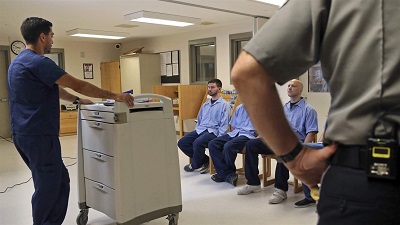Originally Published: 04/23/2020
Post Date: 04/30/2020
by Pew Trust
Summary/Abstract
The most effective therapy for people with opioid use disorder (OUD) involves the use of Food and Drug Administration-approved medications;methadone, buprenorphine, and naltrexone. Despite evidence that this approach, known as medications for opioid use disorder (MOUD), reduces relapse and saves lives; the vast majority of jails and prisons do not offer this treatment.This brief examines what policymakers should consider when exploring how to best manage OUD in incarcerated populations.
It helps to first answer this question: How common is OUD in incarcerated populations? Data from 2007-2009 (the most recent available) showed that more than half of individuals in state prisons or those with jail sentences met the criteria for a non-alcohol and nicotine-related substance use disorder (SUD), meaning a problematic pattern of using a drug that results in impairment in daily life or noticeable distress, compared with only 5 percent of adults in the general population.
The gold standard of care is MOUD. In community-based settings, such as opioid treatment programs and primary care facilities, methadone and buprenorphine have been proved to reduce overdose deaths and illicit opioid use as well as the transmission of infectious diseases such as HIV and hepatitis C. A growing body of literature also exists on the benefits of naltrexone, the third Food and Drug Administration-approved medication.
Within correctional settings in the United States, the use of MOUD is a relatively recent phenomenon, with just a few exceptions. Today, only a small number of correctional institutions provide even one of these medications. Accordingly, there have been fewer studies examining the effects of providing this treatment to people who are incarcerated than there have been for those in communities. However, it’s possible for policymakers to adopt lessons learned from numerous community studies that have demonstrated positive health outcomes from MOUD and then allocate resources to provide this treatment in jails and prisons.
What should policymakers do? Given the high prevalence of SUD among people who are incarcerated, states should prioritize treating these individuals with OUD using methadone or buprenorphine—the medications supported by the most evidence—and then connect them to maintenance care upon re-entry into the community. Doing so will help reduce the number of opioid overdose deaths among those recently released. Connecting people to community treatment is particularly critical in states that have implemented bail reform, which decreases the length of stay in jails. For individuals with shorter stays, jails should consider adopting emergency department protocols: screening and brief intervention, stabilization, initiation of buprenorphine treatment, and referral to community-based treatment.1
Specifically, policymakers should earmark funding to ensure that:
- Jails and prisons are able to screen anyone incarcerated for OUD, and provide MOUD and counseling.
- Jails and prisons have adequate data infrastructure and personnel to track MOUD treatment outcomes.
- Medicaid agencies, state substance use and mental health agencies, and other state and local entities work together to ensure seamless connections to community-based OUD treatment and other services. READ MORE


Leave A Comment